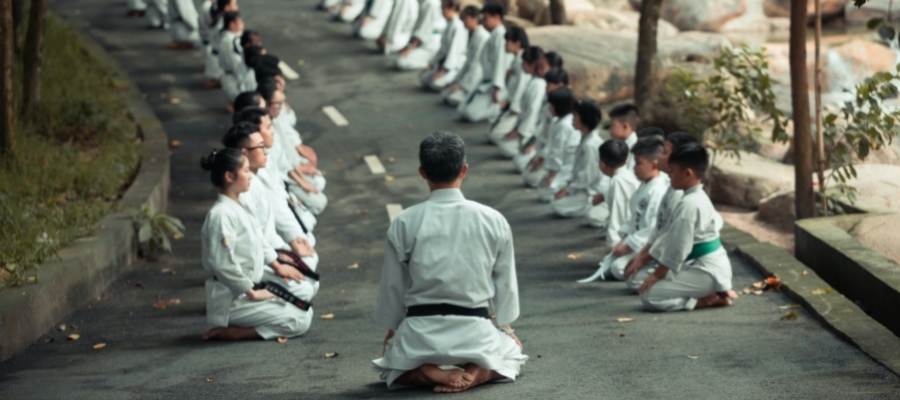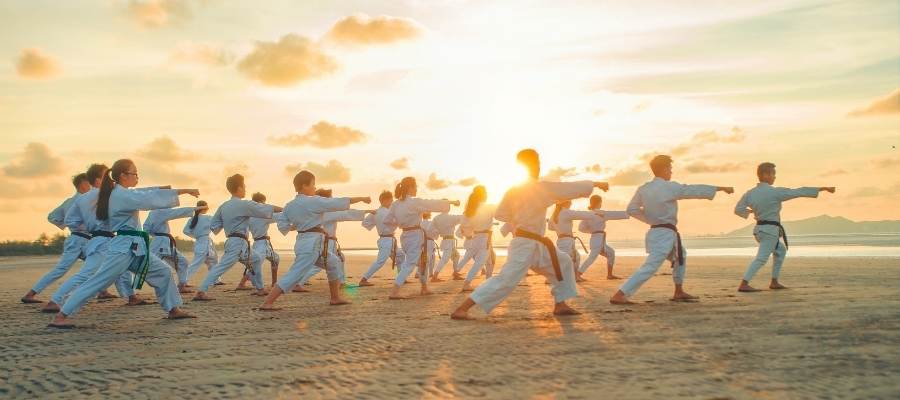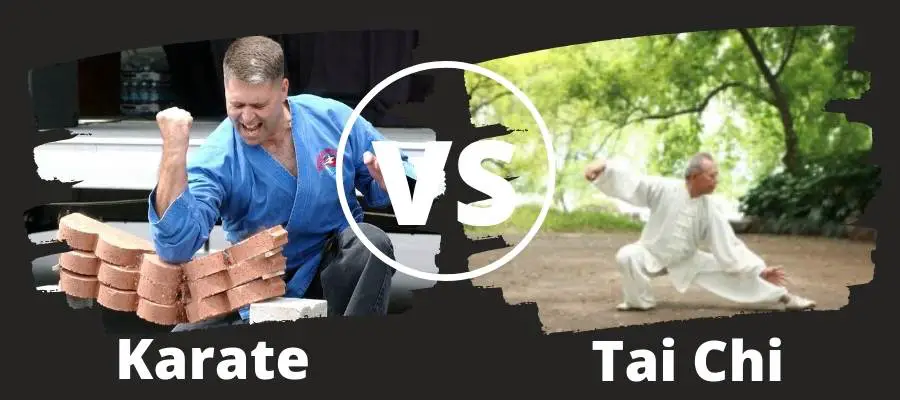My martials arts studies began (further back than I would like to admit!) as a student of Shorin Ryu Karate. It’s a hard, Okinawan style, that preserves the compact footwork, blocks, and strikes that evolved into the larger frame and stepping that most Karate styles are known for today. As I was progressing up through the ranks and training got harder and harder, I saw black belts shifting gears and trying to make their kata (forms) softer and softer. So when I moved to a new city I was intrigued by the internal martials arts and had a hard decision to make choosing between tai chi vs karate.
Comparisons can be made between tai chi vs karate because both systems originated from Chinese martial arts. However, each discipline took a distinctly different developmental path. Karate is a hard style, external martial art that focuses on linear attacks that developed in Japan in the 20th century based on an Okinawan fighting system. Tai chi is an internal or soft martial art style that focuses on health through learning forms based on circular movements.
What I can tell you after over 20 years of practice is that I am a much better tai chi practitioner because I have faced the harder extreme. I had also advanced considerably when I went back to visit my dojo for fun and sparred with the belts above me. I believe that karate and tai chi philosophies are beautifully juxtaposed. One starts soft and progressively hardens by combining internal with external strength. The other starts hard when the body is young and the person is interested in it and transitions towards the soft, making quickness and leverage a bigger part of their game.
In this essay I want to share my experience having practiced both arts because I think it paints how united many traditional martial arts are in the goals they want to eventually obtain despite taking very different paths. We will begin with a bit about the history of karate and tai chi to see how this overlap occurred. At the end I will cover seven considerations you will need to think about if you are choosing between tai chi vs karate.

Tai Chi vs Karate – Origin and Key Differences
Karate has an amazing history. The tie between this martial art and the martial arts of China have been there right from the beginning. It all started on the islands of Okinawa which are part of Japan. Without looking at a map, you wouldn’t necessarily know that Okinawa is almost closer to Taiwan, Hong Kong and China than it is to Japan. The Ryukyu Kingdom, which is now Okinawa, was a Chinese tributary state from the 1400s to the late 1800s. They had a long standing relationship with the dynasties of China and the Ryukyuans standardized a martial art based on kicks, knee strikes, elbow strikes, and open-hand techniques like punches and grabs. This martial art was heavily influenced by the martial arts of China, specifically Southern White Crane.
Japan annexed Okinawa in 1879 and as Ryukyuans migrated to the main island they brought their martial art with them. Japan was militarizing at an epic pace along with their advances in industrialization. Across the next four decades they would seize portions of China, go to war against Russia over Manchuria, seize and occupy the Korean peninsula for 30 years, attack all nearby island groups such as the Philippines, and ultimately even attack the United States in Hawaii, 4000 miles to the east. Pretty staggering once you take it all in.

The short history lesson is important because in it we see the shared roots of karate and tai chi as well as the reason for the massive deviation in the style. The Japanese changed the Okinawan art of “te” or hand to “karate-do” or the “Way of the Open Hand” and standardize the movements. They needed a hard fighting style that could be taught to farmers and laymen going into battle in six months or less for the greater cause of the Japanese Emperor. And with their designs on occupation, most conscripts would be living abroad with a need to fight to maintain their possessions against unwilling subjects.
Fast forward, and what we know of and think of as “karate” is largely influenced by the American military that continues to be stationed in Japan. That and an unending stream of movies from the 1960s forward depicting solely the fighting aspects of the art. Shotokan karate master Shigeru Egami said it best:
“The majority of followers of karate in overseas countries pursue karate only for its fighting techniques … karate as a mysterious way of fighting capable of causing death or injury with a single blow…far from the real thing.”
Shigeru Egami
While there truly is fighting and hard aspects of karate, it also has internal goals and a focus on developing the self.
“Karate may be considered as the conflict within oneself or as a life-long marathon which can be won only through self-discipline, hard training and one’s own creative efforts.”
Okinawan Karate Master Shōshin Nagamine

How is Tai Chi Different from Karate?
As you can imagine, with such dramatically different histories and timelines, the arts that developed out of these two systems would be completely different. When you compare the specifics between the two arts, you basically get a list of opposites. The main differences between tai chi vs karate include:
Primary Differences between Karate and Tai Chi
| Karate | Tai Chi | |
|---|---|---|
| Style | Hard (aggressive) | Soft (yielding and redirecting) |
| Origin | Japan (via Okinawa and China) | China |
| Fighting Theory | Linear attacks | Circular attacks |
| Speed of Techniques | Fast | Slow |
| Competitions | Sparring | Push hands |
| Stances (see specifics) | Closed joints | Open joints |
| Forms | Many short, primarily linear forms | Longer forms in patterns |
| Primary Purpose | Fighting, self defense, fitness | Health, relaxation |
| Additional Purpose | Self-development | Fitness, fighting applications |
Here is a stylized video intended to show the differences between karate and tai chi. It is a fun example with choregraphed movements where these two guys do a great job being true to both styles.
How is Tai Chi Like Karate?
At this point, it might be hard to believe that these two arts share any similar attributes. The more I move on in my years as a tai chi practitioner the more I find myself thinking about the first half decade that I trained in the harder styles. At a higher level, there is definitely shared developmental goals, some shared practices, and overall shared beliefs. Here is how tai chi is like karate:
Forms
Tai chi and Karate both train a series of movements that they have standardized into forms or katas. As you progress, you learn more forms and learn each form at a deeper level. This enables solo practice and a way to gage your progress against others. Not to mention, a safe and fun way to practice together.
Martial Applications
Both Karate and tai chi use open-hand applications within their fighting arts. These include blocks, punches, kicks, leg sweeps, joint locks, jumps, knee and elbow strikes, throws, and attacks to vital areas.
Competitions and Sparring
Karate’s sparring is an open competition of punching and hitting. Tai chi also has sparring competitions known as push hands where two opponents square off in an albeit much more limited fashion. They also have competitions for open-hand and weapon form demonstrations where practitioners debut their form in front of judges.
Weapons
Tai chi and karate both have weapons forms. While most practitioners do not do the weapons forms, the traditional schools still practice them as part of their curriculum. In my opinion weapons is one way that both tai chi and karate excel over other martial arts. No, these weapons are not that practical anymore but they are a lot of fun and are physically demanding. They also teach balance, strength, and concentration.
Many of the karate weapons find their roots in the Okinawan tradition and were farming implements that could be trained to use in fighting. As an example, the bo is a long staff, the tonfa are sticks with handles that were used to plant rice, and the kamas are short scythes for harvesting. Tai chi’s weapons like swords and spears come directly from military use.
Learning and Progress
Both arts have forms which are series of movements that can be learned quickly. However, becoming adept at the forms and movements take several years. Tai chi describes this as a transition from simple choreography to advanced understanding whereas karate transitions from learning the hard style and transitioning into the soft. Both styles add weapons later on as well as more complexity to the movements.
Mental Benefits
While they come at it from completely different directions, practitioners of karate and tai chi both benefit from mental health benefits as well as improvements in awareness, self-esteem and confidence.
Most of the overlap between karate and tai chi occur at a higher level of development. Here is a great discussion between longtime practitioners of tai chi and karate.
Choosing Between Tai Chi vs Karate – Which is Better (for you)?
Hopefully by this point you know that you can’t go wrong when choosing between tai chi vs karate because both traditions are rich in history and have a developed series of curriculum that will provide you and even your family with years of interest, health, and community. However, there are specifics about each art that might make one choice better for you. I have compared tai chi to eight other martial arts and found that these seven aspects are the determining factors for choosing between the two.
Tai Chi vs Karate Fighting and Self Defense
Karate has national and international associations for fighting. Some tai chi schools actively practice push hands and compete in push hands competitions but they are in the minority. If you are interested in fighting, karate is the way to go because a huge percentage of the time spent in class is focusing on strikes and evasions. That being said, both karate and tai chi have a large focus on application and how to use what you are learning in real-life situations.

Physical Fitness
Karate has an amazingly unique curriculum to build physical strength and get fit. I say amazing because the work you do to improve your fitness is measured in the power of your strikes and kicks, your quickness, and even your ability to break boards and bricks! Tai chi is more focused on the health aspect and aids flexibility and balance which does contribute to physical fitness. I would also add that the relaxation, improved sleep, and focus on stress reduction makes whatever you are doing to improve your health faster and more effective. If you are truly looking to improve your fitness using tai chi, then Chen style tai chi is the best option because of their low stances, weapons work, and better balance between martial and health goals.
An additional point I would like to make about karate here is that practitioners cite improved discipline, self confidence, and self esteem from their practice. This means that whatever you choose to improve from work to health to relationships, you will be more successful.
Popularity / Availability of Both Arts
You are more likely to find a tai chi class in your area than you are a karate school. That being said, karate is really popular. Just as tai chi has many different styles. karate has many different lineages such as the original Okinawan arts or the most well known Shotokan.
Ability to Practice
A cool thing about karate is that it has both partner work and has individual forms. This way a person can be practicing on their own with the form work and then practicing with partners in the dojo. For practice with the striking you do need the gear and to be in the school however. Contrast this with tai chi where you can practice nearly everything alone and all you need is a strip of dirt out behind your house.
Community / Socialization
Karate schools are great. They often offer programs for all ages and put together community events, especially around testing for belts. I was exceptionally fortunate with the karate school that I first attended because apart from class they organized meals, chili cookoffs, and joined the Asian cultural festivals to do demonstrations and participate with the other martial arts schools in the areas. Tai chi gets high marks in this area too because the classes are incredibly social and even serve as attendees’ social and community outing.
Expense
Tai chi is probably the most inexpensive martial art in terms of low fees, no testing fees because there is no belt system, little competition, and no need for gear. Karate has a uniform called a gi, the expected dues, and there might be additional fees around testing, attending competitions, gear for competing, and travel.

Need for Gear / Location
Most karate schools do not compete so a gi and a place to practice is about all you need. They do have weapons forms if you work up to that level. If your gym fights, it needs a big space, mats, and the head and hand pads. In addition to that, the school has to have the dummies, striking pads, and we can’t forget about a steady supply of bricks and boards!
Tai chi is known as the “pajama art” for a reason. Schools may have a t-shirt and you want proper shoes but that’s about it unless you are doing the weapons forms and need to make a purchase there.
In summary, karate is more physical, has fighting and fighting competitions, and leans towards the hard and physical side of the martial arts. This is until you have been practicing for several years. Tai chi focuses on the soft side of things, meditative aspects and health benefits. It doesn’t head into the weapons and martial applications until you have made some progress. Here is a summary to help you make your decision between tai chi vs karate.
A Comparison Chart of Tai Chi vs Karate
| Consideration | Tai Chi | Karate |
|---|---|---|
| Self Defense / Fighting | 3 | 7 |
| Physical Fitness | 5 | 7 |
| Popularity / Availability | 10 | 8 |
| Ability to Practice | 10 | 6 |
| Community / Socialization | 7 | 7 |
| Expense | 10 | 8 |
| Need for Gear / Location | 10 | 8 |
| Average | 6.8 | 7.2 |
Choosing Between Tai Chi and Other Martial Arts
This is one of a series of articles covering the similarities and difference between tai chi and other martial arts. We all have very different personalities and luckily there is a martial art for everyone. What is important is that more people on the planet are pursuing fitness that is functional and addressing their external and internal development. Whatever you choice and where ever you are in life, we all benefit by having more people improve themselves and interact with a like-minded community. Check out how all the major martial arts compare to tai chi be clicking on the headings.
| Consideration | Tai Chi | Kung Fu | Wing Chun | Krav Maga | Muay Thai | MMA | Aikido | BJJ | Karate | Taekwondo |
|---|---|---|---|---|---|---|---|---|---|---|
| Self Defense / Fighting | 3 | 5 | 7 | 10 | 10 | 10 | 3 | 10 | 7 | 5 |
| Physical Fitness | 5 | 8 | 7 | 8 | 10 | 10 | 4 | 9 | 7 | 8 |
| Popularity / Availability | 10 | 8 | 8 | 3 | 5 | 9 | 10 | 10 | 8 | 8 |
| Ability to Practice | 10 | 10 | 4 | 3 | 3 | 4 | 6 | 7 | 6 | 10 |
| Community / Socialization | 7 | 7 | 7 | 5 | 4 | 6 | 7 | 8 | 7 | 7 |
| Expense | 10 | 6 | 8 | 8 | 4 | 4 | 8 | 6 | 8 | 6 |
| Need for Gear / Location | 10 | 7 | 8 | 6 | 4 | 4 | 4 | 4 | 8 | 7 |
| Total | 6.8 | 7.2 | 7 | 6.2 | 5.7 | 6.7 | 6 | 7.7 | 7.2 | 7.2 |


